MSI P4M900M3-L User Manual [fr]

FCC-B Radio Frequency Interference Statement
This equipment has been tested and found to comply with the limits for a class B digital device, pursuant to part 15 of the FCC rules. These limits are designed to provide reasonable protection against harmful interference in a residential installation. This equipment generates, uses and can radiate radio frequency energy and, if not installed and used in accordance with the instruction manual, may cause harmful interference to radio communications. However, there is no guarantee that interference will occur in a particular installation. If this equipment does cause harmful interference to radio or television reception, which can be determined by turning the equipment off and on, the user is encouraged to try to correct the interference by one or more of the measures listed below.
Reorient or relocate the receiving antenna.
Increase the separation between the equipment and receiver.
Connect the equipment into an outlet on a circuit different from that to which the receiver is connected.
Consult the dealer or an experienced radio/ television technician for help.
Notice 1
The changes or modifications not expressly approved by the party responsible for compliance could void the user’s authority to operate the equipment.
Notice 2
Shielded interface cables and A.C. power cord, if any, must be used in order to comply with the emission limits.
VOIR LA NOTICE D’NSTALLATION AVANT DE RACCORDER AU RESEAU.
Micro-Star International
MS-7387
G52-73871X1
i
Copyright Notice
The material in this document is the intellectual property of MICRO-STAR INTERNATIONAL. We take every care in the preparation of this document, but no guarantee is given as to the correctness of its contents. Our products are under continual improvement and we reserve the right to make changes without notice.
Trademarks
All trademarks are the properties of their respective owners.
AMD®, Athlon™ Athlon™XP, Thoroughbred™ and Duron™ are registered trademarks of AMD® Corporation.
Intel® and Pentium® are registered trademarks of Intel Corporation.
PS/2 and OS®/2 are registered trademarks of International Business Machines Corporation.
Microsoft® is a registered trademark of Microsoft Corporation. Windows® 98/2000/NT/XP are registered trademarks of Microsoft Corporation.
NVIDIA®, the NVIDIA logo, DualNet, and nForce are registered trademarks or trademarks of NVIDIA® Corporation in the United States and/or other countries.
Netware® is a registered trademark of Novell, Inc.
Award® is a registered trademark of Phoenix Technologies Ltd.
AMI® is a registered trademark of American Megatrends Inc.
Kensington and MicroSaver are registered trademarks of the Kensington Technology Group.
PCMCIA and CardBus are registered trademarks of the Personal Computer Memory Card International Association.
Revision History
Revision |
Revision History |
Date |
V1.0 |
First release |
August. 2007 |
ii

Safety Instructions
Always read the safety instructions carefully.
Keep this User Manual for future reference.
Keep this equipment away from humidity.
Lay this equipment on a reliable flat surface before setting it up.
The openings on the enclosure are for air convection hence protects the equipment from overheating. Do not cover the openings.
Make sure the voltage of the power source and adjust properly 110/220V before connecting the equipment to the power inlet.
Place the power cord such a way that people can not step on it. Do not place anything over the power cord.
Always Unplug the Power Cord before inserting any add-on card or module.
All cautions and warnings on the equipment should be noted.
Never pour any liquid into the opening that could damage or cause electrical shock.
If any of the following situations arises, get the equipment checked by a service personnel:
-The power cord or plug is damaged.
-Liquid has penetrated into the equipment.
-The equipment has been exposed to moisture.
-The equipment does not work well or you can not get it work according to User Manual.
-The equipment has dropped and damaged.
-The equipment has obvious sign of breakage.
Do not leave this equipment in an environment unconditioned, storage temperature above 60° C (140°F), it may damage the equipment.
CAUTION: Danger of explosion if battery is incorrectly replaced. Replace only with the same or equivalent type recommended by the manufacturer.
iii

WEEE Statement
ENGLISH
To protect the global environment and as an environmentalist, MSI must remind you that...
Under the European Union ("EU") Directive on Waste Electrical and Electronic Equipment, Directive 2002/96/EC, which takes effect on August 13, 2005, products of "electrical and electronic equipment" cannot be discarded as municipal waste anymore and manufacturers of covered electronic equipment will be obligated to take back such products at the end of their useful life. MSI will comply with the product take back requirements at the end of life of MSI-branded products that are sold into the EU. You can return these products to local collection points.
DEUTSCH
Hinweis von MSI zur Erhaltung und Schutz unserer Umwelt
Gemäß der Richtlinie 2002/96/EG über Elektround Elektronik-Altgeräte dürfen Elektround Elektronik-Altgeräte nicht mehr als kommunale Abfälle entsorgt werden. MSI hat europaweit verschiedene Sammelund Recyclingunternehmen beauftragt, die in die Europäische Union in Verkehr gebrachten Produkte, am Ende seines Lebenszyklus zurückzunehmen. Bitte entsorgen Sie dieses Produkt zum gegebenen Zeitpunkt ausschliesslich an einer lokalen Altgerätesammelstelle in Ihrer Nähe.
FRANÇAIS
En tant qu’écologiste et afin de protéger l’environnement, MSI tient à rappeler ceci...
Au sujet de la directive européenne (EU) relative aux déchets des équipement électriques et électroniques, directive 2002/96/EC, prenant effet le 13 août 2005, que les produits électriques et électroniques ne peuvent être déposés dans les décharges ou tout simplement mis à la poubelle. Les fabricants de ces équipements seront obligés de récupérer certains produits en fin de vie. MSI prendra en compte cette exigence relative au retour des produits en fin de vie au sein de la communauté européenne. Par conséquent vous pouvez retourner localement ces matériels dans les points de collecte.
РУССКИЙ
Компания MSI предпринимает активные действия по защите окружающей среды, поэтому напоминаем вам, что....
В соответствии с директивой Европейского Союза (ЕС) по предотвращению загрязнения окружающей среды использованным электрическим и электронным оборудованием (директива WEEE 2002/96/EC), вступающей в силу 13 августа 2005 года, изделия, относящиеся к электрическому и электронному оборудованию, не могут рассматриваться как бытовой мусор, поэтому производители вышеперечисленного электронного оборудования обязаны принимать его для переработки по окончании срока службы. MSI обязуется соблюдать требования по приему продукции, проданной под маркой MSI на территории EC, в переработку по окончании срока службы. Вы можете вернуть эти изделия в специализированные пункты приема.
ESPAÑOL
MSI como empresa comprometida con la protección del medio ambiente, recomienda:
Bajo la directiva 2002/96/EC de la Unión Europea en materia de desechos y/o equipos electrónicos, con fecha de rigor desde el 13 de agosto de 2005, los productos clasificados como "eléctricos y equipos electrónicos" no pueden ser depositados en los contenedores habituales de su municipio, los fabricantes de equipos electrónicos, están obligados a hacerse cargo de dichos productos al termino de su período de vida. MSI estará comprometido con los términos de recogida de sus productos vendidos en la Unión Europea al final de su periodo de vida. Usted debe depositar estos productos en el punto limpio establecido por el ayuntamiento de su localidad o entregar a una empresa autorizada para la recogida de estos residuos.
NEDERLANDS
Om het milieu te beschermen, wil MSI u eraan herinneren dat….
De richtlijn van de Europese Unie (EU) met betrekking tot Vervuiling van Electrische en Electronische producten (2002/96/EC), die op 13 Augustus 2005 in zal gaan kunnen niet meer beschouwd worden als vervuiling.
Fabrikanten van dit soort producten worden verplicht om producten retour te nemen aan het eind van hun levenscyclus. MSI zal overeenkomstig de richtlijn handelen voor de producten die de merknaam MSI dragen en verkocht zijn in de EU. Deze goederen kunnen geretourneerd worden op lokale inzamelingspunten.
iv
SRPSKI
Da bi zaštitili prirodnu sredinu, i kao preduzeće koje vodi računa o okolini i prirodnoj sredini, MSI mora da vas podesti da…
Po Direktivi Evropske unije ("EU") o odbačenoj ekektronskoj i električnoj opremi, Direktiva 2002/96/EC, koja stupa na snagu od 13. Avgusta 2005, proizvodi koji spadaju pod "elektronsku i električnu opremu" ne mogu više biti odbačeni kao običan otpad i proizvođači ove opreme biće prinuđeni da uzmu natrag ove proizvode na kraju njihovog uobičajenog veka trajanja. MSI će poštovati zahtev o preuzimanju ovakvih proizvoda kojima je istekao vek trajanja, koji imaju MSI oznaku i koji su prodati u EU. Ove proizvode možete vratiti na lokalnim mestima za prikupljanje.
POLSKI
Aby chronić nasze środowisko naturalne oraz jako firma dbająca o ekologię, MSI przypomina, że...
Zgodnie z Dyrektywą Unii Europejskiej ("UE") dotyczącą odpadów produktów elektrycznych i elektronicznych (Dyrektywa 2002/96/EC), która wchodzi w życie 13 sierpnia 2005, tzw. “produkty oraz wyposażenie elektryczne i elektroniczne " nie mogą być traktowane jako śmieci komunalne, tak więc producenci tych produktów będą zobowiązani do odbierania ich w momencie gdy produkt jest wycofywany z użycia. MSI wypełni wymagania UE, przyjmując produkty (sprzedawane na terenie Unii Europejskiej) wycofywane z użycia. Produkty MSI będzie można zwracać w wyznaczonych punktach zbiorczych.
TÜRKÇE
Çevreci özelliğiyle bilinen MSI dünyada çevreyi korumak için hatırlatır:
Avrupa Birliği (AB) Kararnamesi Elektrik ve Elektronik Malzeme Atığı, 2002/96/EC Kararnamesi altında 13 Ağustos 2005 tarihinden itibaren geçerli olmak üzere, elektrikli ve elektronik malzemeler diğer atıklar gibi çöpe atılamayacak ve bu elektonik cihazların üreticileri, cihazların kullanım süreleri bittikten sonra ürünleri geri toplamakla yükümlü olacaktır. Avrupa Birliği’ne satılan MSI markalı ürünlerin kullanım süreleri bittiğinde MSI ürünlerin geri alınması isteği ile işbirliği içerisinde olacaktır. Ürünlerinizi yerel toplama noktalarına bırakabilirsiniz.
ČESKY
Záleží nám na ochraně životního prostředí - společnost MSI upozorňuje...
Podle směrnice Evropské unie ("EU") o likvidaci elektrických a elektronických výrobků 2002/96/EC platné od 13. srpna 2005 je zakázáno likvidovat "elektrické a elektronické výrobky" v běžném komunálním odpadu a výrobci elektronických výrobků, na které se tato směrnice vztahuje, budou povinni odebírat takové výrobky zpět po skončení jejich životnosti. Společnost MSI splní požadavky na odebírání výrobků značky MSI, prodávaných v zemích EU, po skončení jejich životnosti. Tyto výrobky můžete odevzdat v místních sběrnách.
MAGYAR
Annak érdekében, hogy környezetünket megvédjük, illetve környezetvédőként fellépve az MSI emlékezteti Önt, hogy ...
Az Európai Unió („EU") 2005. augusztus 13-án hatályba lépő, az elektromos és elektronikus berendezések hulladékairól szóló 2002/96/EK irányelve szerint az elektromos és elektronikus berendezések többé nem kezelhetőek lakossági hulladékként, és az ilyen elektronikus berendezések gyártói kötelessé válnak az ilyen termékek visszavételére azok hasznos élettartama végén. Az MSI betartja a termékvisszavétellel kapcsolatos követelményeket az MSI márkanév alatt az EU-n belül értékesített termékek esetében, azok élettartamának végén. Az ilyen termékeket a legközelebbi gyűjtőhelyre viheti.
ITALIANO
Per proteggere l’ambiente, MSI, da sempre amica della natura, ti ricorda che….
In base alla Direttiva dell’Unione Europea (EU) sullo Smaltimento dei Materiali Elettrici ed Elettronici, Direttiva 2002/96/EC in vigore dal 13 Agosto 2005, prodotti appartenenti alla categoria dei Materiali Elettrici ed Elettronici non possono più essere eliminati come rifiuti municipali: i produttori di detti materiali saranno obbligati a ritirare ogni prodotto alla fine del suo ciclo di vita. MSI si adeguerà a tale Direttiva ritirando tutti i prodotti marchiati MSI che sono stati venduti all’interno dell Unione Europea alla fine del
loro ciclo di vita. È possibile portare i prodotti nel più vicino punto di raccolta.
v
Table of Content |
|
English........................... |
1 |
Français......................... |
13 |
Deutsch ......................... |
25 |
Русском......................... |
37 |
........................ |
49 |
........................ |
61 |
............................ |
73 |
vi

INTRODUCTION
Thank you for choosing the P4M900M3 series (MS-7387 v1.x) Micro-ATX mainboard. The P4M900M3 series is design based on VIA®P4M900 / VIA®VT8237S chipsets for optimal system efficiency. Designed to fit the advanced Intel® Pentium 4 processor, the P4M900M3 series deliver a high performance and professional desktop platform solution.
Layout
Top : mouse |
|
Bottom: |
CPU_FAN1 |
keyboard |
Top : Parallel Port |
Bottom: |
COM port |
VGA port |
JPW1
USB Ports
|
|
|
|
VIA |
Top : LAN Port |
|
|
|
P4M900 |
|
|
|
|
|
Bottom: |
|
|
|
|
USB Ports |
|
|
|
|
T:Line-In |
|
|
|
|
M:Line-Out |
|
|
|
|
B:Mic |
|
|
|
|
T:RS-Out |
|
JCI1 |
|
|
M:CS-Out |
|
|
|
|
PCIE16X1 |
|
|
||
B:SS-Out |
|
|
||
|
PCI 1 |
|
|
|
|
PCI 2 |
|
|
|
|
|
FDD 1 |
|
BATT |
|
|
|
|
+ |
JCD1 |
JAUD1 |
JSP1 |
JBAT1 |
|
|
|
|||
|
|
|
||
|
|
SYS_FAN1 |
JUSB1 |
JUSB2 |
DIMM2
DIMM 1
IDE 1 CONN 1
JSPI1 |
SATA1 |
VIA |
SATA2 |
|
|
8237S |
|
|
JFP2 |
JFP1 |
|
1
SPECIFICATIONS
Processor Support
zSupports Intel® LGA 775 processor
zSupports 95W Cedarmill CPU (3xx, 6xx Non-D Stepping CPU)
zSupports 95W Smithfield CPU (8xx CPU)
zSupports 95W Presler CPU (9xx CPU)
zSupports 84W Prescott Celeron CPU (3xx CPU)
zSupports 84W Prescott CPU (5xx, 6xx CPU)
zSupports 65W Cedarmill CPU (3xx, 6xx D Stepping CPU)
zSupports 65W Conroe CPU (E6xx, E4xx, E2xx CPU)
zFMB 2005A and VRM11 support CPU TDP=95W
(For the latest information about CPU, please visit http://global.msi.com.tw/index.php?func=cpuform)
Supported FSB
z 1066 / 800/ 533 MHz
Chipset
zNorth Bridge: VIA® P4M900 chipset
zSouth Bridge: VIA® VT8237S chipset
Memory Support
zDDR2 400/ 533/ 667 SDRAM (4GB Max)
z2 DDR2 DIMMs (240pin/ 1.8V)
(For more information on compatible components, please visit http://global.msi.com.tw/index.php?func=testreport)
LAN
z Supports 10/100/1000 Fast Ethernet by RTL8201CL / RTL8111B(optional)
Audio
zChip integrated by Realtek ALC888
zHD 7.1-channel audio
IDE
z1 IDE port
zSupports Ultra DMA 66/100/133 mode
zSupports PIO, Bus Master operation mode
SATA
z2 SATAII ports
zSupports 2 SATAII devices
zSupports storage and data transfers at up to 300 MB/s
Floppy
z1 floppy port
zSupports 1 FDD with 360K, 720K, 1.2M, 1.44M and 2.88Mbytes
2
Connectors
zBack panel
-1 PS/2 mouse port
-1 PS/2 keyboard port
-1 serial port (COM1)
-1 parallel port supporting SPP/EPP/ECP mode
-1 D-Sub VGA port
-4 USB 2.0 Ports
-1 LAN jack
-6 flexible audio jacks
zOn-Board Pinheaders / Connectors
-1 front Audio pinheader
-1 CD-in pinheader
-2 USB 2.0 pinheaders
-1 Chassis Intrusion Switch pinheader
Slots
z1 PCI Express x16 slot
z2 PCI slots
zSupport 3.3V / 5V PCI bus Interface
Form Factor
z Micro-ATX (24.4cm X 20.0 cm)
Mounting
z 6 mounting holes
3

REAR PANEL
The rear panel provides the following connectors:
Mouse |
Parallel Port |
LAN |
|
|
|
|
|
|
|
|
|
|
|
|
|
Line-In RS-Out |
|
|
|
|
|
Line-Out CS-Out |
|
Keyboard |
Serial port |
VGA port |
USB ports |
MIC |
SS-Out |
HARDWARE SETUP
This chapter tells you how to install the CPU, memory modules, and expansion cards, as well as how to setup the jumpers on the mainboard. It also provides the instructions on connecting the peripheral devices, such as the mouse, keyboard, etc. While doing the installation, be careful in holding the components and follow the installation procedures.
CPU & Cooler Installation Procedures for LGA775
When you are installing the CPU, make sure the CPU has a cooler attached on the top to prevent overheating. Meanwhile, do not forget to apply some thermal paste on CPU before installing the heat sink/cooler fan for better heat dispersion.
Follow the steps below to install the CPU & cooler correctly. Wrong installation will cause the damage of your CPU & mainboard.
Introduction to LGA 775 CPU
The pin-pad side of LGA 775 CPU. |
The surface of LGA 775 CPU. |
1.The CPU socket has a plastic cap on it to protect the contact from damage. Before you have installed the CPU, always cover it to protect the socket pin.
2.Remove the cap from lever hinge side.
3.The pins of socket reveal.
4.Open the load lever.
5.Lift the load lever up and open the load plate.
4
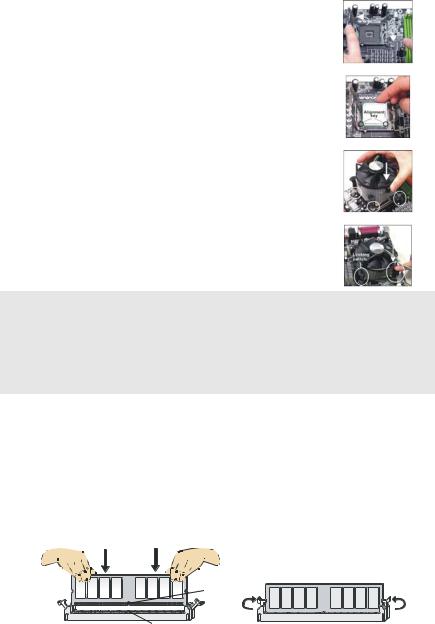
6.After confirming the CPU direction for correct mating, put down the CPU in the socket housing frame. Be sure to grasp on the edge of the CPU base. Note that the alignment keys are matched.
7.Visually inspect if the CPU is seated well into the socket. If not, take out the CPU with pure vertical motion and reinstall.
8.Cover the load plate onto the package.
9.Press down the load lever lightly onto the load plate, and then secure the lever with the hook under retention tab.
10.Align the holes on the mainboard with the cooler. Push down the cooler until its four clips get wedged into the holes of the mainboard.
11.Press the four hooks down to fasten the cooler. Then rotate the locking switch (refer to the correct direction marked on it) to lock the hooks.
12.Turn over the mainboard to confirm that the clip-ends are correctly inserted.
Important:
Read the CPU status in BIOS.
Whenever CPU is not installed, always protect your CPU socket pin with the plastic cap covered to avoid damaging.
Mainboard photos shown in this section are for demonstration of the CPU/cooler installation only. The appearance of your mainboard may vary depending on the model you purchase.
Installing Memory Modules
1.The memory module has only one notch on the center and will only fit in the right orientation.
2.Insert the memory module vertically into the DIMM slot. Then push it in until the golden finger on the memory module is deeply inserted in the DIMM slot. You can barely see the golden finger if the memory module is properly inserted in the DIMM slot.
3.The plastic clip at each side of the DIMM slot will automatically close.
Notch
Volt
5

Important:
DDR2 memory modules are not interchangeable with DDR and the DDR2 standard is not backwards compatible. You should always install DDR2 memory modules in the DDR2 DIMM slots.
To enable successful system boot-up, always insert the memory modules into the DIMM1 first.
ATX 24-Pin Power Connector: CONN1
This connector allows you to connect an ATX 24-pin power supply. To connect the ATX 24-pin power supply, make sure the plug of the power supply is inserted in the proper orientation and the pins are aligned. Then push down the power supply firmly into the connector.
You may use the 20-pin ATX power supply as you like. If you like to use the 20-pin ATX power supply, please plug your power supply along with pin 1 & pin 13 (refer to the image at the right hand).
ATX 12V Power Connector: JPW1
This 12V power connector is used to provide power to the CPU.
Important:
+3.3V |
|
|
GND |
+12V |
|
|
+5V |
+12V |
|
|
+5V |
5VSB |
|
|
+5V |
PWR OK |
|
|
Res |
GND |
|
|
GND |
+5V |
|
|
GND |
GND |
|
|
GND |
+5V |
|
|
PS-ON# |
GND |
|
|
GND |
+3.3V |
|
|
-12V |
+3.3V |
|
|
+3.3V |
GND |
|
|
GND |
|
|
||
|
|
||
+12V |
|
|
+12V |
|
|
|
|
|
|
|
|
Make sure that all the connectors are connected to proper ATX power supplies to ensure stable operation of the mainboard.
Power supply of 350 watts (and above) is highly recommended for system stability.
ATX 12V power connection should be greater than 18A.
Floppy Disk Drive Connector: FDD1
This connector supports 360KB, 720KB, 1.2MB, 1.44MB or 2.88MB floppy disk drive.
IDE Connector: IDE1
This connector supports IDE hard disk drives, optical disk drives and other IDE devices.
Important:
If you install two IDE devices on the same cable, you must configure the drives to cable select mode or separately to master / slave mode by setting jumpers. Refer to IDE device documentation supplied by the vendors for jumper setting instructions.
Serial ATA Connector: SATA1 / SATA2
This connector is a high-speed Serial ATA interface port. Each connector can connect to one Serial ATA device.
6
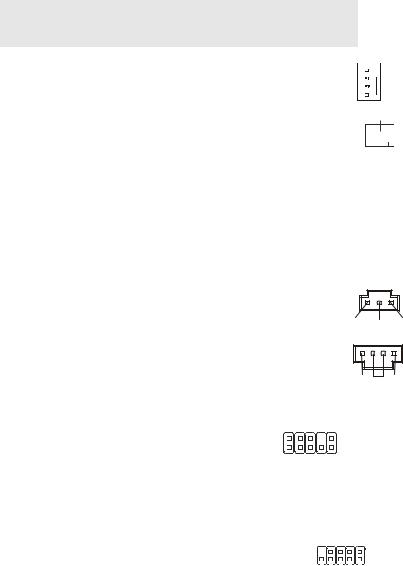
Important:
Please do not fold the Serial ATA cable into 90-degree angle. Otherwise, data loss may occur during transmission.
Fan Power Connectors: CPU_FAN1, SYS_FAN1
The fan power connectors support system cooling fan with +12V. When connecting the wire to the connectors, always note that the red wire is the positive and should be connected to the +12V; the black wire is Ground and should be connected to GND. If the mainboard has a System Hardware Monitor chipset on-board, you must use a specially designed fan with speed sensor to take advantage of the CPU fan control.
 Control
Control
 Sensor
Sensor
+12V
 GND
GND
+12V
GND 



 Sensor
Sensor
Chassis Intrusion Connector: JCI1
This connector connects to the chassis intrusion switch cable. If the chassis is opened, the chassis intrusion mechanism will be activated. The system will record this status and show a warning message on the screen. To clear the warning, you must enter the BIOS utility and clear the record.
1 2
CINTRU  GND
GND
S/PDIF-Out Connector: JSP1
This connector is used to connect S/PDIF (Sony & Philips Digital Interconnect Format) interface for digital audio transmission.
VCC SPDIF GND
CD-In Connector: JCD1
This connector is provided for external audio input.
|
|
|
|
|
|
|
|
|
|
|
|
L GND R |
|||
Front Panel Audio |
|
|
MIC2_JD |
|
|
|
|
|
|
||||||
|
VCC5 |
|
NC |
|
|
|
|
|
|
||||||
|
|
|
|
|
|
|
|
||||||||
Connector: JAUD1 |
|
|
|
|
|
|
|
|
|||||||
(2)GND |
|
|
|
|
|
|
|
|
|
|
|
|
Line_JD(10) |
||
This connector allows you to connect the |
|
|
|
|
|
|
|
|
|
|
|
|
|||
|
|
|
|
|
|
|
|
|
|
|
|
||||
front panel audio and is compliant with |
(1)MIC_L |
|
|
|
|
|
|
|
|
|
|
|
|
Line-out_L(9) |
|
|
|
|
|
|
|
|
|
|
|
|
|
||||
Intel® Front Panel I/O Connectivity Design |
|
|
|
|
|
|
|
|
|
|
|
|
|
|
|
|
MIC_R |
|
Front to Sense |
||||||||||||
Guide. |
|
|
|||||||||||||
|
Line-out_R |
|
|
|
|
|
|
||||||||
|
|
|
|
|
|
|
|
||||||||
Front USB Connector: |
|
|
|
|
|
|
|
USB0+ |
|||||||
JUSB1/ JUSB2 |
|
|
|
|
|
|
GND |
|
USB0- |
||||||
|
|
|
|
|
|
|
|||||||||
This connector, compliant with Intel® I/O |
(9)Key,no pin |
|
|
|
|
|
|
|
|
|
|
VCC(1) |
|||
Connectivity Design Guide, is ideal for |
|
|
|
|
|
|
|
|
|
|
|||||
|
(10)N.C. |
|
|
|
|
|
|
|
|
|
|
VCC(2) |
|||
connecting high-speed USB interface |
|
|
|
|
|
|
|
|
|
|
|
|
|
|
|
peripherals such as USB HDD, digital |
|
|
|
|
|
|
GND |
|
USB1- |
||||||
cameras, MP3 players, printers, modems and |
|
|
USB1+ |
||||||||||||
the like. |
|
|
|
|
|
|
|
|
|
|
|
|
|
|
|
7

Front Panel Connectors: JFP1, JFP2
These connectors are for electrical connection to the front panel switches and LEDs. The JFP1 is compliant with Intel® Front Panel I/O Connectivity Design Guide.
JFP2
JFP1
|
|
8 |
7 |
Speaker |
|
|
Power |
|
|
|
LED |
|
|
2 |
1 |
Power Power |
|||
LED |
Switch |
||
2 |
|
+ |
- |
|
|
10 |
|
1 |
|
|
9 |
+ |
- |
- |
+ |
HDD Reset |
|||
LED |
Switch |
||
Clear CMOS Jumper: JBAT1 |
|
|
|
|
|
|
|
|
|
|
There is a CMOS RAM onboard that has a power supply |
|
|
|
|
|
|
|
|
|
|
from an external battery to keep the data of system |
1 |
2 |
3 |
1 |
2 |
3 |
1 |
2 |
3 |
|
configuration. With the CMOS RAM, the system can |
||||||||||
|
|
|
|
|
|
|
|
|
||
automatically boot OS every time it is turned on. If you want |
|
|
|
Keep Data |
Clear Data |
|||||
to clear the system configuration, set the jumper to clear |
|
|
|
|
|
|
|
|
|
|
data. |
|
|
|
|
|
|
|
|
|
|
Important:
You can clear CMOS by shorting 2-3 pin while the system is off. Then return to 1-2 pin position. Avoid clearing the CMOS while the system is on; it will damage the mainboard.
PCI (Peripheral Component Interconnect) Express Slot
The PCI Express slot supports the PCI Express interface expansion card.
The PCI Express x 16 slot supports up to 4.0 GB/s transfer rate.
PCI (Peripheral Component Interconnect) Slot
The PCI slot supports LAN card, SCSI card, USB card, and other add-on cards that comply with PCI specifications.
Important:
When adding or removing expansion cards, make sure that you unplug the power supply first. Meanwhile, read the documentation for the expansion card to configure any necessary hardware or software settings for the expansion card, such as jumpers, switches or BIOS configuration.
PCI Interrupt Request Routing
The IRQ, acronym of interrupt request line and pronounced I-R-Q, are hardware lines over which devices can send interrupt signals to the microprocessor. The PCI IRQ pins are typically connected to the PCI bus pins as follows:
8
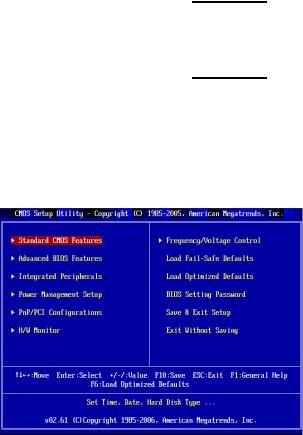
|
Order1 |
Order2 |
Order3 |
Order4 |
|
|
|
|
|
PCI Slot1 |
INT B# |
INT C# |
INT D# |
INT A# |
|
|
|
|
|
PCI Slot2 |
INT C# |
INT D# |
INT A# |
INT B# |
|
|
|
|
|
BIOS Setup
Power on the computer and the system will start POST (Power On Self Test) process. When the message below appears on the screen, press <DEL> key to enter Setup.
Press DEL to enter SETUP
If the message disappears before you respond and you still wish to enter Setup, restart the system by turning it OFF and On or pressing the RESET button. You may also restart the system by simultaneously pressing <Ctrl>, <Alt>, and <Delete> keys.
Main Page
Standard CMOS Features
Use this menu for basic system configurations, such as time, date etc.
Advanced BIOS Features
Use this menu to setup the items of special enhanced features.
Integrated Peripherals
Use this menu to specify your settings for integrated peripherals.
Power Management Setup
Use this menu to specify your settings for power management.
PNP/PCI Configurations
This entry appears if your system supports PnP/PCI.
9

H/W Monitor
This entry shows the status of your CPU, fan, warning for overall system status.
Frequency/Voltage Control
Use this menu to specify your settings for frequency/voltage control.
Load Fail-Safe Defaults
Use this menu to load the BIOS default values that are factory settings for system operations.
Load Optimized Defaults
Use this menu to load factory default settings into the BIOS for stable system performance operations.
BIOS Setting Password
Use this menu to set BIOS setting Password.
Save & Exit Setup
Save changes to CMOS and exit setup.
Exit Without Saving
Abandon all changes and exit setup.
Frequency/Voltage Control
Current CPU/DRAM Frequency
It shows the current frequency of CPU/DRAM. Read-only.
Intel EIST
The Enhanced Intel SpeedStep technology allows you to set the performance level of the microprocessor whether the computer is running on battery or AC power. This field will appear after you installed the CPU which support speedstep technology.
Advance DRAM Configuration > DRAM Timing
10

This field allows you to select the memory timing setting. Setting to [Auto] enables Max Memclock (Mhz) automatically to be determined by SPD. Selecting [Manual] allows users to configure these fields manually.
Advance DRAM Configuration > 1T CMD Support
This field allows you to enable/disable the memory 1T CMD rate support.
Adjust PCI/PCI Express Frequency
This field allows you to select the PCI/PCIE frequency (in MHz).
Auto Disable DIMM/PCI Clock
When set to [Enabled], the system will remove (turn off) clocks from empty DIMM and PCI slots to minimize the electromagnetic interference (EMI).
Adjust DDR/NB Voltage
These items allow you to adjust the Memory/North Bridge voltage. Adjusting the voltage can increase the speed. Any changes made to this setting may cause a stability issue, so changing the voltage for long-term purpose is NOT recommended.
Spread Spectrum
When the motherboard’s clock generator pulses, the extreme values (spikes) of the pulses create EMI (Electromagnetic Interference). The Spread Spectrum function reduces the EMI generated by modulating the pulses so that the spikes of the pulses are reduced to flatter curves. If you do not have any EMI problem, leave the setting at Disabled for optimal system stability and performance. But if you are plagued by EMI, set to Enabled for EMI reduction. Remember to disable Spread Spectrum if you are overclocking because even a slight jitter can introduce a temporary boost in clock speed which may just cause your overclocked processor to lock up.
Important:
If you do not have any EMI problem, leave the setting at [Disabled] for optimal system stability and performance. But if you are plagued by EMI, select the value of Spread Spectrum for EMI reduction.
The greater the Spread Spectrum value is, the greater the EMI is reduced, and the system will become less stable. For the most suitable Spread Spectrum value, please consult your local EMI regulation.
Remember to disable Spread Spectrum if you are overclocking because even a slight jitter can introduce a temporary boost in clock speed which may just cause your overclocked processor to lock up.
11

Load Optimized Defaults
You can load the default values provided by the mainboard manufacturer for the stable performance.
12
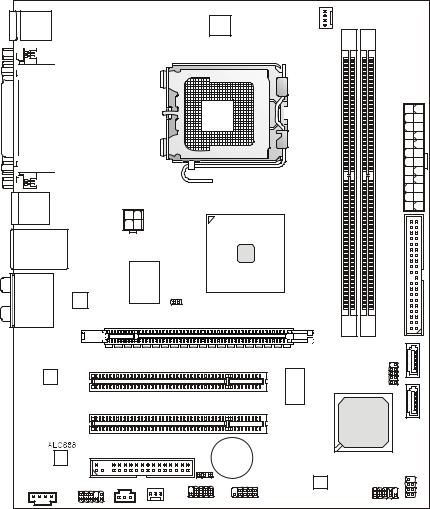
INTRODUCTION
Félicitations, vous venez d’acquérir une carte mère des séries Micro-ATX P4M900M3 (MS-7387 v1.x). Les P4M900M3 séries sont basées sur les chipsets VIA®P4M900 / VIA®VT8237S offrant un système très performant. La carte fonctionne avec les processeurs Intel® Pentium 4. Les Séries P4M900M3 sont très performantes et offrent une solution adaptée tant aux professionnels qu’aux particuliers.
Schéma
Top : mouse |
|
Bottom: |
CPU_FAN1 |
keyboard |
Top : Parallel Port |
Bottom: |
COM port |
VGA port |
JPW1
USB Ports
|
|
|
|
VIA |
Top : LAN Port |
|
|
|
P4M900 |
|
|
|
|
|
Bottom: |
|
|
|
|
USB Ports |
|
|
|
|
T:Line-In |
|
|
|
|
M:Line-Out |
|
|
|
|
B:Mic |
|
|
|
|
T:RS-Out |
|
JCI1 |
|
|
M:CS-Out |
|
|
|
|
PCIE16X1 |
|
|
||
B:SS-Out |
|
|
||
|
PCI 1 |
|
|
|
|
PCI 2 |
|
|
|
|
|
FDD 1 |
|
BATT |
|
|
|
|
+ |
JCD1 |
JAUD1 |
JSP1 |
JBAT1 |
|
|
|
|||
|
|
|
||
|
|
SYS_FAN1 |
JUSB1 |
JUSB2 |
DIMM2
DIMM 1
IDE 1 CONN 1
JSPI1 |
SATA1 |
VIA |
SATA2 |
|
|
8237S |
|
|
JFP2 |
JFP1 |
|
13
SPÉCIFICITÉS
Processeurs Supportés
zSupporte Intel® LGA 775 processeur
zSupporte 95W Cedarmill CPU (3xx, 6xx Non-D Stepping CPU)
zSupporte 95W Smithfield CPU (8xx CPU)
zSupporte 95W Presler CPU (9xx CPU)
zSupporte 84W Prescott Celeron CPU (3xx CPU)
zSupporte 84W Prescott CPU (5xx, 6xx CPU)
zSupporte 65W Cedarmill CPU (3xx, 6xx D Stepping CPU)
zSupporte 65W Conroe CPU (E6xx, E4xx, E2xx CPU)
zFMB 2005A et VRM11 supportent CPU TDP=95W
(Pour les dernières mises à jours concernant les CPU, vous pouvez visiter : http://global.msi.com.tw/index.php?func=cpuform
FSB Supporté
z 1066 / 800/ 533 MHz
Chipset
zNorth Bridge : chipset VIA® P4M900
zSouth Bridge : chipset VIA® VT8237S
Mémoire Supporté
zDDR2 400/ 533/ 667 SDRAM (4GB Max)
z2 DDR2 DIMMs (240pin/ 1.8V)
(Pour plus d’information, veuillez visiter http://global.msi.com.tw/index.php?func=testreport)
LAN
z Supporte 10/100/1000 Fast Ethernet par RTL8201CL / RTL8111B(optionnel)
Audio
zPuce intégrée par Realtek ALC888
zCanaux Audio HD 7.1
IDE
z1 port IDE
zSupporte Ultra DMA 66/100/133 mode
zSupporte PIO, Bus Master operation mode
SATA
z2 ports SATAII
zSupporte 2 périphériques SATAII
zSupporte un stockage et un taux de transfert jusqu’à 300 MB/s
Disquette
z1 port de disquette
zSupporte 1 FDD avec 360K, 720K, 1.2M, 1.44M et 2.88Mbytes
14
Connecteurs
zPanneau arrière
-1 port souris PS/2
-1 port clavier PS/2
-1 port série (COM1)
-1 port parallèle supportant SPP/EPP/ECP mode
-1 port D-Sub VGA
-4 ports USB 2.0
-1 jack LAN
-6 audio jacks flexibles
zConnecteurs intégrés
-1 connecteur Audio
-1 connecteur CD-IN
-2 connecteurs USB 2.0
-1 connecteur Chassis Intrusion Switch
Slots
z1 slot PCI Express x16
z2 slots PCI
zSupporte 3.3V / 5V PCI bus Interface
Dimension
z Micro-ATX (24.4cm X 20.0 cm)
Montage
z 6 trous de montage
15
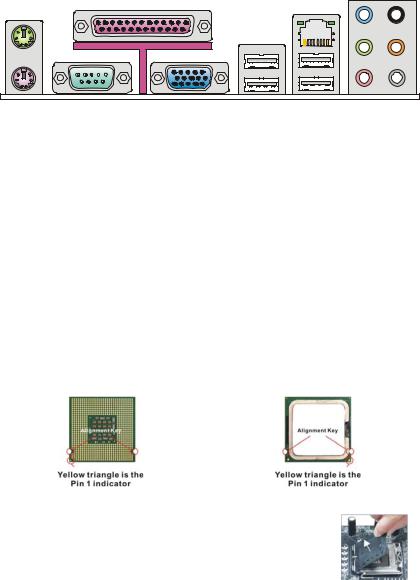
Panneau Arrière
Le panneau arrière dispose les connecteurs suivants :
Mouse |
Parallel Port |
LAN |
|
|
|
|
|
|
|
|
|
|
|
|
|
Line-In RS-Out |
|
|
|
|
|
Line-Out CS-Out |
|
Keyboard |
Serial port |
VGA port |
USB ports |
MIC |
SS-Out |
Installation Matériel
Ce chapitre vous indique comment installer le CPU, les modules de mémoire, les cartes d’extension et les cavaliers. Il explique également comment connecter périphériques tels que la souris, le clavier etc. Lors de l’installation du matériel, veuillez suivre les instructions de montage pour éviter d’endommager quoi que ce soit.
Procédure d’installation de CPU et du ventilateur de LGA775
Quand vous installerez votre CPU, assurez-vous que le CPU possède un système de refroidissement pour prévenir les surchauffes. Si vous ne possédez pas de système de refroidissement, contactez votre revendeur pour vous en procurer un et installer le avant d’allumer l’ordinateur. N’oubliez pas d’utiliser une pâte thermique en silicium sur le CPU avant d’installer votre ventilateur afin d’avoir une meilleure dispersion de la chaleur. Suivez les mesures suivantes pour installer correctement le système de refroidissement et le CPU, sinon vous risquez d’endommager votre CPU et votre Carte mère.
Introduction de VGA 775 CPU
The pin-pad side of LGA 775 CPU. |
The surface of LGA 775 CPU. |
1.Le socket du CPU comporte un couvercle en plastique pour le protéger des contacts qui lui causeraient des dommages. Avant d’installer le CPU, toujours couvrir et protéger les pins du socket.
2.Enlevez le chapeau du côté du levier.
3.Les goupilles de la douille se montent.
16

4.Ouvrez le levier effectif.
5.Soulevez le levier effectif et ouvrez le plat effectif.
6.Après avoir vérifié le bon sens du CPU, déposez le CPU sur le socket. Notez qu’on aligne les broches.
7.Inspectez visuellement, si le CPU est bien posé dans la douille. Dans le cas contraire retirez le CPU avec un mouvement vertical et réinstallez-le.
8.Couvrez le plat effectif sur le paquet.
9.Appuyez légèrement sur le levier effectif et sur le plat effectif, fixez ensuite le levier avec le crochet de rétention.
10.Alignez les trous de la carte avec le ventilateur. Installez le ventilateur dans les trous de la carte mère.
11.Appuyer sur les crochets pour fixer le ventilateur. Puis effectuer une rotation des systèmes de rétention (voir ventilateur pour le sens de rotation).
12.Retournez la carte mère pour s’assurer que le ventilateur est correctement installé.
Important:
Lisez le statut du CPU.
Lorsque le CPU n’est pas installé, protégez toujours le pin du socket de votre CPU avec le couvercle en plastique pour éviter de l’endommager
Les photos de la carte mère présentées dans cette section ne sont pas contractuelles. Votre carte mère peut être différente selon le module acheté.
Installer les Modules de Mémoire
1.Le module de mémoire ne possède qu’une encoche en son centre. Ainsi il n’est possible de monter le module que dans un seul sens.
2.Insérez verticalement le module de mémoire dans le slot DIMM. Puis appuyez dessus.
3.Le clip en plastique situé de chaque côté du module va se fermer automatiquement.
Notch
Volt
Important:
Les modules de mémoire DDR2 ne sont pas interchangeables par DDR et vice versa.
17
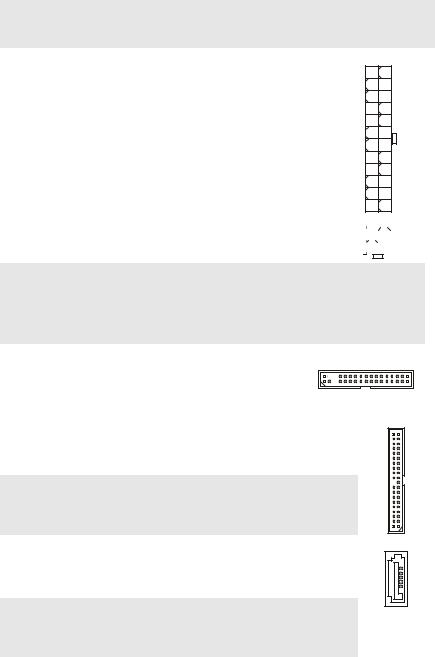
Vous devez installer toujours les modules de mémoire DDR2 dans les slots DDR2 DIMM.
Pour lancer avec succès votre ordinateur, insérez tout d’abord les modules de mémoire dans le DIMM1.
Connecteur d’alimentation ATX 24-Pin:CONN1
Ce connecteur vous permet de connecter l’alimentation ATX 24-pin. Pour cela, assurez-vous que la prise d’alimentation est bien positionnée dans le bon sens et que les goupilles soient alignées. Enfoncez alors la prise dans le connecteur.
Vous pouvez aussi utiliser une alimentation 20-pin selon vos besoins. Veuillez brancher votre alimentation d'énergie avec le pin1 et le pin 13 si vous voulez utiliser l’alimentation ATX 20-pin. (référez-vous à l’image du côté droit).
Connecteur d’alimentation TX12V:JPWR1
Le connecteur d’alimentation 12V est utilisé pour alimenter le CPU.
Important:
+3.3V |
|
|
GND |
+12V |
|
|
+5V |
+12V |
|
|
+5V |
5VSB |
|
|
+5V |
PWR OK |
|
|
Res |
GND |
|
|
GND |
+5V |
|
|
GND |
GND |
|
|
GND |
+5V |
|
|
PS-ON# |
GND |
|
|
GND |
+3.3V |
|
|
-12V |
+3.3V |
|
|
+3.3V |
GND |
|
|
GND |
|
|
||
|
|
||
+12V |
|
|
+12V |
|
|
||
|
|
|
|
Assurez-vous que tous les connecteurs sont reliés à l’alimentation ATX pour assurer une stabilité de la carte mère.
L’alimentation 350 watts (ou supérieur) est recommandée pour la stabilité du système. La connexion d’alimentation ATX 12V devrait être plus importante que 18A.
Connecteur Floppy Disk Drive:FDD1
La carte mère comporte un connecteur standard pour un lecteur de disquette qui supporte les formats 360KB, 720KB, 1.2MB, 1.44MB et 2.88MB.
Connecteur IDE: IDE1
Ce connecteur supporte les disques durs IDE, les lecteurs du disque optique et d’autres dispositifs IDE.
Important:
Si vous voulez installer deux disques durs, vous devez configurer le second en Esclave en configurant le cavalier. Vous pouvez vous référer à la documentation du disque dur pour les instructions.
Connecteurs Série ATA: SATA1 / SATA2
Ce connecteur est un port d’interface de haute vitesse Série ATA. Chaque connecteur peut se connecter à un dispositif Série ATA.
Important:
Veuillez ne pas tordre le câble Série ATA à 90 degrés. Cela pourrait l’endommager et entraîner la perte de données lors des phases de transfert de celles-ci.
18

Connecteurs d’alimentation du ventilateur: CPU_FAN, SYS_FAN
Les connecteurs d’alimentation du système de refroidissement supportent un système de refroidissement de +12V. Lors de la connexion du câble, assurez-vous que le fil rouge soit connecté au +12V et le fil noir connecté au “GND“. Si la carte mère possède un système de gestion intégré, vous devez utiliser un ventilateur ayant ces caractéristiques si vous voulez contrôler le ventilateur du CPU.
Châssis Intrusion Connector: JCI1
Ce connecteur est connecté à un cable chassis intrusion switch. Si le châssis est ouvert, le switch en informera le système, qui enregistrera ce statut et affichera un écran d’alerte. Pour effacer ce message d’alerte, vous devez entrer dans le BIOS et désactiver l’alerte.
 Control
Control
 Sensor
Sensor
+12V
 GND
GND
+12V
GND 



 Sensor
Sensor
1 2 CINTRU  GND
GND
Connecteur Sortie S/PDIF: SPDOUT1
Ce connecteur est utilisé pour connecter l’interface SPDIF (Sony &
Philips Digital Interconnect Format) pour une transmission VCC SPDIF GND numérique audio.
Connecteur CD-Entrée: JCD1
Ce connecteur est fournit pour l’entrée audio externe.
|
|
|
|
|
|
|
|
L GND R |
|
Connecteur Audio |
|
|
MIC2_JD |
||||||
|
VCC5 |
|
NC |
||||||
|
|
||||||||
Panneau avant: JAUD1 |
|
|
|||||||
(2)GND |
|
|
|
|
|
|
|
Line_JD(10) |
|
Ce connecteur est utilisé pour connecter |
|
|
|
|
|
|
|
||
|
|
|
|
|
|
|
|||
les audio avant. Il est compatible avec |
(1)MIC_L |
|
|
|
|
|
|
|
Line-out_L(9) |
|
|
|
|
|
|
|
|||
Intel® Front Panel I/O Connectivity Design |
|
|
|
|
|
|
|
|
|
|
MIC_R |
|
Front to Sense |
||||||
Guide. |
|
|
|||||||
|
Line-out_R |
||||||||
|
|
||||||||
Connecteur Front USB: JUSB1/JUSB2
La carte mère procure deux connecteurs standard 2.0 JUSB1&JUSB2. La technologie USB 2.0 accroît le taux de transfert jusqu’à 480Mbps, ce qui est 40 fois plus rapide que l’ USB 1.1. Idéal pour connecter des périphériques gourmand en bande passante (appareil photo numérique, caméra numérique etc).
USB0+
GND USB0-
(9)Key,no pin 















 VCC(1) (10)N.C.
VCC(1) (10)N.C. 








 VCC(2)
VCC(2)
GND USB1-
USB1+
19
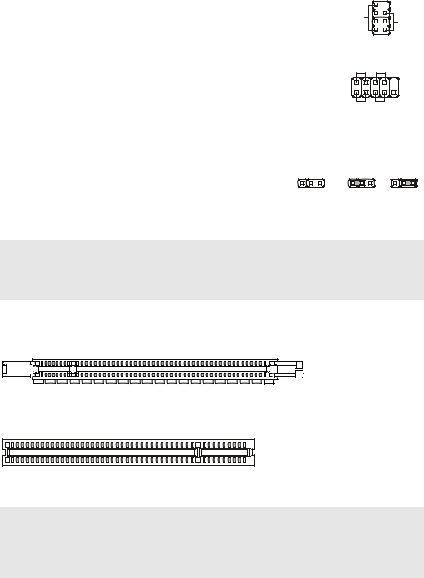
Connecteurs Panneau Audio en Façade: JFP1, JFP2
La carte mère possède deux connecteurs sur le panneau avant pour les branchements électriques (LED, disque dur…). JFP1 est compatible avec l’intel Front Panel I/O Connectivity Design Guide.
JFP2
JFP1
|
|
8 |
7 |
Speaker |
|
|
Power |
|
|
|
LED |
|
|
2 |
1 |
Power Power |
|||
LED |
Switch |
||
2 |
|
+ |
- |
|
|
10 |
|
1 |
|
|
9 |
+ |
- |
- |
+ |
HDD Reset |
|||
LED |
Switch |
||
Cavalier Effacer COMS: JBAT1 |
|
|
|
|
|
|
|
|
|
|
Le CMOS RAM intégré reçoit une alimentation d’une |
|
|
|
|
|
|
|
|
|
|
batterie externe qui permet de garder les données de |
1 |
2 |
3 |
1 |
2 |
3 |
1 |
2 |
3 |
|
configuration du système. Avec le CMOS RAM, le système |
||||||||||
|
|
|
|
|
|
|
|
|
||
peut automatiquement démarrer avec les paramètres |
|
|
|
Keep Data |
Clear Data |
|||||
personnalisés du BIOS à chaque fois que le PC est allumé. |
|
|
|
|
|
|
|
|
|
|
Si vous voulez effacer la configuration du système, utilisez le JBAT1 pour effacer les données.
Important:
Vous pouvez effacer le CMOS en positionnant le cavalier sur les broches 2-3 lorsque le PC n’est pas allumé. Puis il faut remettre le cavalier en position 1-2. Ne surtout pas effacer le CMOS lorsque le PC est allumé, cela endommagera la carte mère.
Slot PCI Express (Peripheral Component Interconnect)
Le slot PCI Express supporte la carte d’extension de l’interface PCI Express.
Le slot PCI Expressx16 supporte un taux de transfert jusqu’à 4.0 GB/s
Slot PCI (Peripheral Component Interconnect)
Le slot PCI supporte la carte LAN, la carte SCSI, la carte USB, et d’autres cartes ajoutées qui obéissent aux spécificités PCI.
Important:
Lorsque vous ajoutez ou retirez une carte d’extension, assurez-vous que le PC n’est pas relié au secteur. Lisez la documentation pour faire les configurations nécessaires du matériel ou du logiciel de la carte d’extension, tels que cavaliers, commutateurs ou la configuration du BIOS.
20
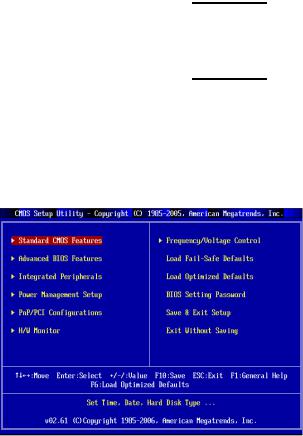
PCI Interrupt Request Routing
IRQ est l’abréviation de “interrupt request line”. Les IRQ sont des signaux émis par des matériaux. Les PCI IRQ sont connectés généralement aux broches PCI bus INT A# ~ INT D# comme ci-dessous:
|
Order1 |
Order2 |
Order3 |
Order4 |
|
|
|
|
|
PCI Slot1 |
INT B# |
INT C# |
INT D# |
INT A# |
|
|
|
|
|
PCI Slot2 |
INT C# |
INT D# |
INT A# |
INT B# |
|
|
|
|
|
BIOS Setup
Lorsque le PC démarre, le processus de POST (Power On Self Test) se met en route. Quand le message ci-dessous apparaît à l’écran, appuyer sur <DEL> pour accéder au Setup.
Si le message disparaît avant que n’ayez appuyé sur la touche, redémarrez le PC avec l’aide du bouton RESET. Vous pouvez aussi redémarrer en utilisant la combinaison des touches <Ctrl>, <Alt>, et <Suppr>.
Page Principale
Standard CMOS Features
Cette fonction permet le paramétrage des éléments standard du BIOS tels que l’heure, etc
Advanced BIOS Features
Cette fonction permet de paramétrer des éléments avancés du BIOS.
Integrated Peripherals
Utilisez ce menu pour paramétrer les périphériques intégrés.
21
